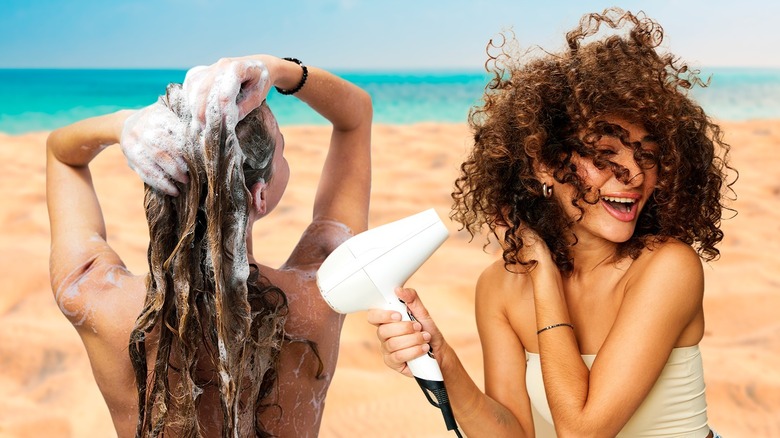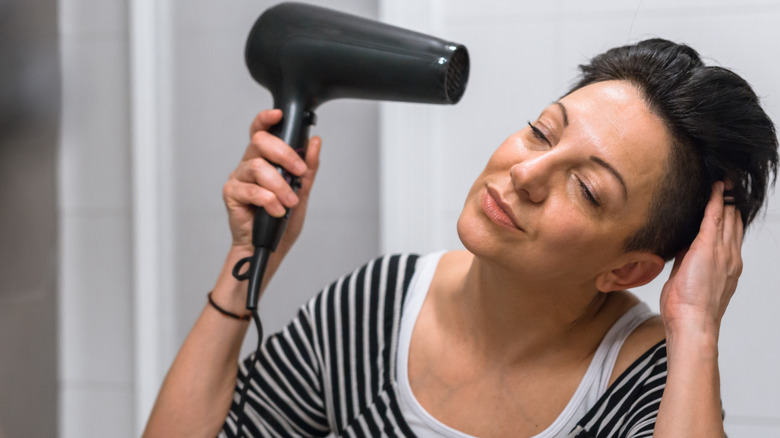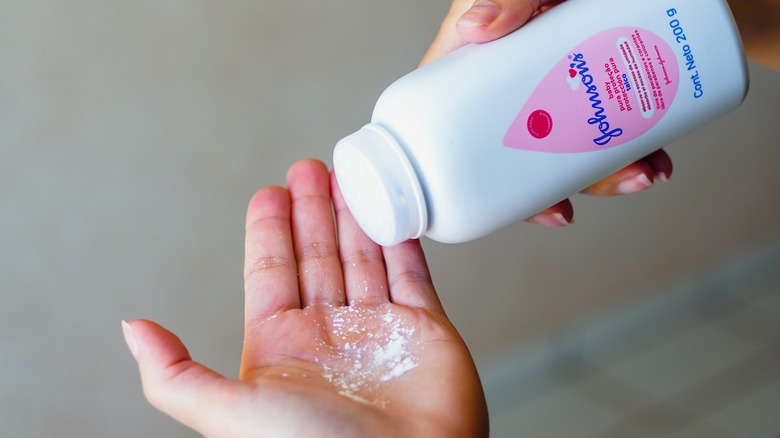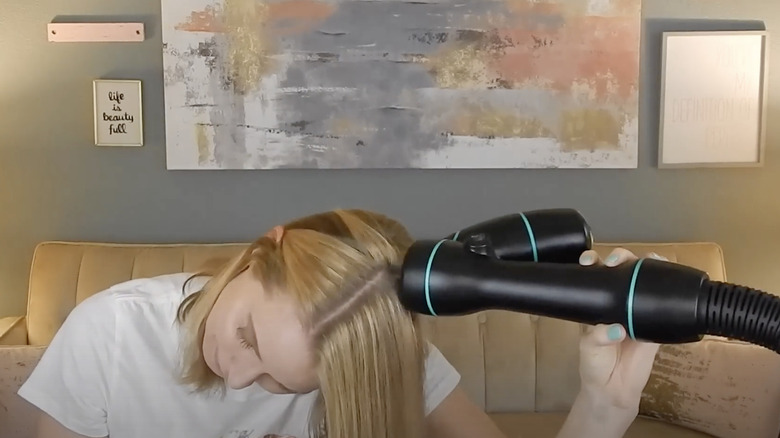Tips For Getting The Sand Out Of Your Hair After A Day At The Beach
Depending on where you live in the world, beach days may be a year-long thing — and how lucky you are if that's the case. But as much as many of us love a day in the sun and sea, the sand can be a bit much, especially when you get it in your hair. All you need is a little wind and a pop into the water for a few minutes and sand can easily make its way into your hair and onto your scalp. That can, of course, create gorgeous beach day hair, but the sand can be an annoying component to that gorgeousness.
While sand isn't going to do any damage to your scalp or hair, you probably still want to ditch as much of it as you can — it can make a head feel sort of crunchy and itchy, to say the least. Although the easiest way may be to rinse it out, if that's not an option, you'll need to resort to one of a few creative ways to manage the sand situation and get your locks back into sand-free territory.
Flip and tousle
Perhaps this isn't the fastest way to get sand out of your hair, but it is the best way to keep those beach waves intact. Start by allowing your hair to dry on its own, as this tip can be a little tricky when your hair is still wet. If you're in the sun, it shouldn't take too long to dry. If you can't wait it out in the sun for your hair to lose its moisture and need to hop in the car, then skip the air conditioning and roll down the windows so the wind can do its thing. This is also a great opportunity to turn up the music and pretend you're in a movie where you're driving away into a new chapter of your life.
When your hair is completely dry, flip your head upside down — not in the vicinity of any place you want sand to get in — and give your hair a proper tousle while massaging your scalp with your fingers. As you do this, the excess sand will fall from your hair. Not all of it will be removed, but enough will be so you don't feel like your head is an extension of the seashore.
Use a hairdryer
The easiest and speediest way to get sand out of your hair is by blowing it out with a hairdryer. Before you do this, however, you want to give your head a quick rub to get any of that thick wet sand unstuck from your scalp — it will make the process even quicker. When you turn on the hairdryer, set it to cool so you don't have to worry about heat damage (your hair isn't protected by products, after all, and is more prone to damage when it's wet) or irritating your scalp that might have gotten a little too much sun at the beach.
Because the sand is likely to blow every which way, if you choose this option to get sand out of your hair, you want to do it outside or in a contained space like a dry shower so cleanup is as easy as possible, per EnviroMom.
Scratch the sand out
It doesn't matter how little or how much sand you managed to catch at the beach — giving your head a good scratch with your fingers will loosen things up. In fact, it will loosen things up enough that you don't want to do this in a place that will cause a mess like, say, on your carpet — this is an outdoor or dry shower only technique. Travel blog Hopdes also recommends shaking the excess sand out of your strands, and then going over it with a wide-tooth comb to pick up any grains your fingers may have missed.
If you're concerned that sliding the sand through your hair with your fingers is somehow going to damage it, don't be. Sand actually exfoliates not just the scalp but the hair, giving the follicles a chance to breathe, via Selebriti. Perfect, exfoliated beach hair, here you come.
Use baby powder
When you combine water and sand, trying to remove it from anything can be a struggle. But you can nip that battle in the bud if you sprinkle baby powder on your hair, according to Curl Centric. This bathroom staple will absorb the moisture in your hair and scalp, so it's easier to remove the sand. Once you apply the baby powder, give it a few minutes so it can strip as much dampness as possible.
When things start feeling somewhat dry, you can comb out the sand or give your head a good headbanger type of shake. You may find that not all the powder is completely removed at this stage, so you have a slight gray-like halo. If this happens to be the case, you can either not sweat it and embrace the gray hair look, or you can continue combing and shaking your head until enough of it is gone.
Use dry shampoo
If you're someone who loves dry shampoo and already uses it regularly, then you can skip the baby powder and go straight for the dry shampoo instead. While the powder was absorbing just moisture, dry shampoo does that and then some. "The alcohol or starch in the product soaks up the excess oil and grease in your hair, giving it a cleaner, fresher appearance," dermatologist Wilma Bergfeld, M.D., tells Cleveland Clinic. "The scalp collects chemicals and pollutants both from the air and from cosmetic care products. Dry shampoo freshens your hair by removing oils, but its actual cleansing power is only minimal."
In other words, as much as this option is great and will allow you to skip washing your hair for a longer amount of time, keeping your beach hair looking fabulous, you'll eventually have to give your hair and scalp a thorough scrub with actual shampoo.
Vacuum it
No, this isn't a joke. Depending on what kind of vacuum cleaner you have, this is an option that can really work for those pesky sand particles that don't want to leave your head. The best way to do this is hold the nozzle a couple inches from your head when your hair is dry, turn the vacuum on, and make your way around your scalp, per The Mestiza Muse. You don't want to move too fast because you want the vacuum to have time to suck up the sand, but you also don't want to move too slow because you don't want the vacuum to suck up your hair instead, creating snarls and tangles.
Before you actually try this technique, you want to make sure the nozzle is clean and you have a vacuum that can be used in this way. If your vacuum cleaner doesn't have a nozzle attachment or isn't one of those handy-dandy Dustbusters, this isn't for you. Trying to roll a floor brush over your head is not only useless, but dangerous. There's really no sense in knocking yourself out in an attempt to eliminate beach day sand.
Rinse and condition
Although it's definitely going to take a few rounds of rinsing, if you have access to sand-free water, like a shower at the beach or at home, then that's where you should go. Showering may not be as exciting at vacuuming your head, but it's also far easier. However, when you get in the shower, don't shampoo; conditioner is all you need. "Salt is very alkaline, so the best way to counteract the alkaline is with a conditioner because a conditioner is an acid," Australian Mane Master Kevin Murphy tells Mane Addicts. "The conditioner will balance up the pH and take hair back to normal very quickly."
In a couple days you can get back to washing your hair, if you choose. But considering the positive effects that salt water has on hair, in regards to texture, you may want to wait as long as possible to wash your hair again so you don't lose the beach hair look.
Plan ahead next time
While you can't go back in time and prevent sand from getting in your hair, you can plan ahead for next time. Avoid getting it in your hair in the first place by being proactive in choosing a head covering like a hat or scarf. If you're not one for such accessories, then putting your hair in a bun or in braids is another option. Granted, an updo or braids won't totally prevent an invasion of sand, but it will definitely minimize the amount you would have collected if you just left your hair down and blowing in the wind.
Sand in your hair may be an annoying side effect that comes with going to the beach, but considering all the fun you had, don't let it ruin your day. The sand isn't doing any damage, your hair is looking fantastic, and you have that perfect after-beach glow of someone who responsibly used sunblock with SPF30.








